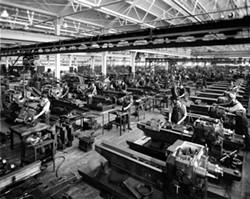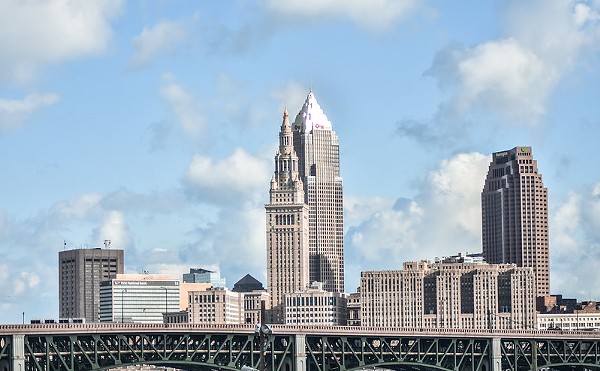Cleveland's City Planning Commission will be, in an upcoming meeting of its board, scrutinizing a ready concept of the Warner & Swasey Building's future: a totally remodeled, five-story apartment complex.
Priced last August at a $36 million construction cost, the concept includes intentions from Pennrose, its Philadelphia-based developer, to build 140 units of affordable and market-rate housing, including 56 apartments for seniors and 56 for lower-income families. Along with, as Pennrose Development Director Geoff Milz told the Plain Dealer, a roof deck for prime downtown skyline views.
Pennrose's readiness for concept review suggests the project is nearing its funding goals. Late last year, the firm garnered a $1 million grant from the city of Cleveland, along with $12 million in low-income tax credits that May. (Calls to Pennrose's Ohio office were unreturned Thursday afternoon.)

Other than acting as a poetic emblem of Cleveland's Rust Belt chic, the Warner & Swasey building also represents a symbol of the city's prewar power as a manufacturing hub. Its revitalization, both to hungry urbanists and area councilmembers, acts as a marker of Cleveland's gradual return to growth in and around the central core.
Erected by New England machinists Worcester Reed Warner and Ambrose Swasey in the 1880s, the structure was a powerhouse for an array of topical tools—from bespoke telescopes (like one for the U.S. Naval Observatory) to World War II-era plane parts and turret lathes.
By the 1960s, white flight to the suburbs threatened the building's energy. By 1965, Warner and Swasey's worker base was halved, to about 2,000 employees. Come the Reaganomics of the 1980s, the building was sold to out-of-towner Bendix Corp., which threatened to gut the building altogether.
Politicians saw it as a marker of Cleveland's downfall.
“What the hell are we doing to keep people in this town?” Councilman Joe Cannon asked the Plain Dealer at the time. “Do we take care of the business that we’ve got? You’ve got to hold what you’ve got, and maybe take a few from [the suburbs].”
In 1992, all structures and links to Warner & Swasey were gone in Northeast Ohio. It wasn't until 2019 when the building was added to the National Register of Historic Places.
Cleveland's City Planning Commission will be discussing its conceptual plans next week. If approved, construction could start sometime in 2025.
Subscribe to Cleveland Scene newsletters.
Follow us: Apple News | Google News | NewsBreak | Reddit | Instagram | Facebook | Twitter | Or sign up for our RSS Feed














